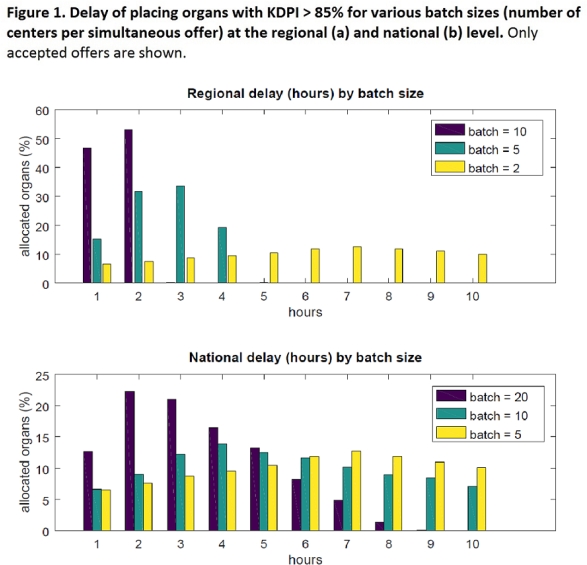Estimated Impact of the Number of Simultaneous Offers on Kidney Delay and Discard
1King Abdullah University of Science and Technology, Thuwal, Saudi Arabia
2Johns Hopkins University, Baltimore
3University of Maryland, College Park
4US Naval Academy, Annapolis.
Meeting: 2018 American Transplant Congress
Abstract number: 427
Keywords: Allocation, Kidney, Kidney transplantation
Session Information
Session Name: Concurrent Session: Kidney Deceased Donor Allocation - 2
Session Type: Concurrent Session
Date: Tuesday, June 5, 2018
Session Time: 2:30pm-4:00pm
 Presentation Time: 3:06pm-3:18pm
Presentation Time: 3:06pm-3:18pm
Location: Room 6E
Following local decline of a recovered kidney, making regional and national offers in larger simultaneous batches might decrease discards. We simulated varying batch sizes for offers stratified by KDPI, and described likelihood of discard and delay.
METHODS: Using 2010 KPSAM-SRTR data, we simulated allocation of 3090 organs, comparing current practice to one of making (one-hour) expiring simultaneous offers to batches of transplant centers. Kidneys not matched after 10 rounds of offers were classified as discarded for excessive delay. We excluded locally allocated and 0-MM kidneys. We assumed each hour's delay increases discard probability by 5%.
RESULTS: Discard and delay decreased with increasing batch size (Table 1). Among regionally accepted offers with KDPI>85%, batch size of 2/5/10 centers resulted in 23%/81%/100% placed within 3 hours of delay. Among nationally accepted offers, batch size of 5/10/20 centers resulted in 23%/28%/56% placed within 3 hours of delay (Figure 1). For KDPI>85%, making national offers in batches of 10 centers rather than 5 decreased discard to 34% from 71%. The probability of accepting but not receiving an organ (because a higher-priority candidate received the kidney) with regional offer batch size of 10 was 38% for KDPI<0.25 and 7% for KDPI>0.85.
CONCLUSION: Making expiring simultaneous kidneys offers at regional and national levels might decrease delays and discard without over-burdening providers. For high KDPI kidneys, increasing the batch size might decrease delay of placement.
Table 1. Discard rate per KDPI level and batch size (b).
| Regional | ||
| bKDPI | [0%,85%) | [85%,100%] |
| 1 | 73% | 88% |
| 2 | 35% | 72% |
| 5 | 28% | 68% |
| 10 | 27% | 67% |
| all | 27% | 66% |
| National | ||
| bKDPI | [0%,85%) | [85%,100%] |
| 1 | 89% | 98% |
| 5 | 55% | 71% |
| 15 | 8% | 18% |
| 20 | 6% | 17% |
| all | 5% | 16% |
CITATION INFORMATION: Mankowski M., Raghavan S., Holscher C., Kosztowski M., Segev D., Gentry S. Estimated Impact of the Number of Simultaneous Offers on Kidney Delay and Discard Am J Transplant. 2017;17 (suppl 3).
To cite this abstract in AMA style:
Mankowski M, Raghavan S, Holscher C, Kosztowski M, Segev D, Gentry S. Estimated Impact of the Number of Simultaneous Offers on Kidney Delay and Discard [abstract]. https://atcmeetingabstracts.com/abstract/estimated-impact-of-the-number-of-simultaneous-offers-on-kidney-delay-and-discard/. Accessed November 25, 2025.« Back to 2018 American Transplant Congress

